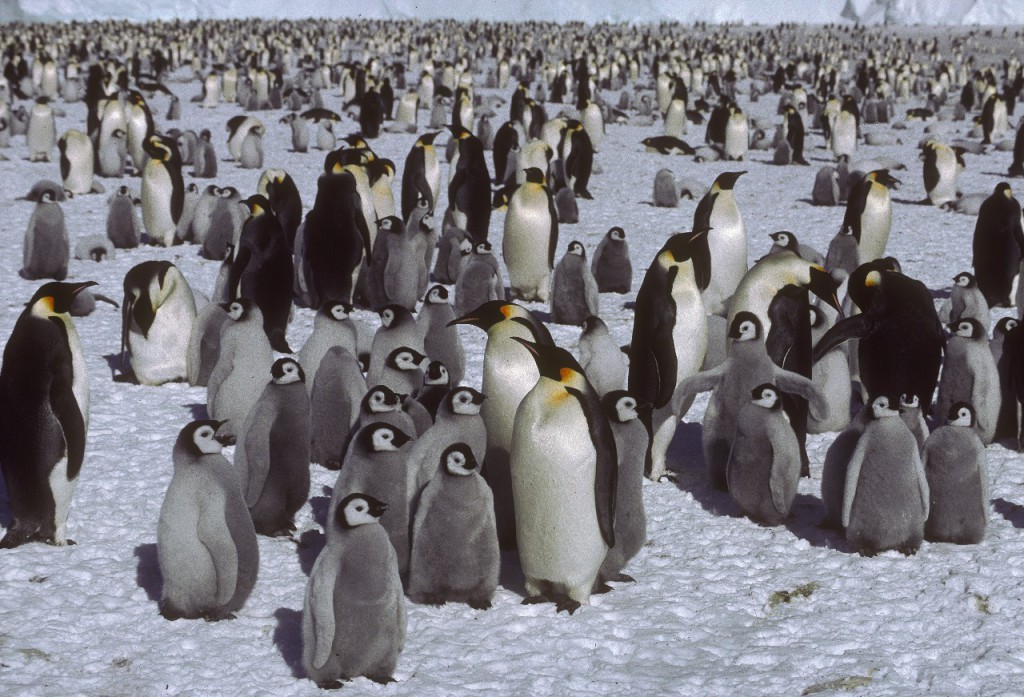Antarctic emperor penguins may be adapting to warmer temperatures
A new study of four Antarctic emperor penguin colonies suggest that unexpected breeding behaviour may be a sign that the birds are adapting to environmental change.

Analysis of satellite observations reveals that penguin colonies moved from their traditional breeding grounds during years when the thin layer of ice (sea ice) formed later than usual to the much thicker floating ice shelves that surround the continent.
Reporting this week in the online journal, PLOS ONE, a team of scientists from British Antarctic Survey (BAS), the Australian Antarctic Division and the Scripps Institution of Oceanography at UC San Diego in California, describe this extraordinary change in behaviour.
Lead author, Peter Fretwell of BAS said,
“These charismatic birds tend to breed on the sea ice because it gives them relatively easy access to waters where they hunt for food. Satellite observations captured of one colony in 2008, 2009 and 2010 show that the concentration of annual sea ice was dense enough to sustain a colony. But this was not the case in 2011 and 2012 when the sea ice did not form until a month after the breeding season began. During those years the birds moved up onto the neighbouring floating ice shelf to raise their young.
“What’s particularly surprising is that climbing up the sides of a floating ice shelf – which at this site can be up to 30 metres high – is a very difficult manoeuvre for emperor penguins. Whilst they are very agile swimmers they have often been thought of as clumsy out of the water.”
The emperor penguins’ reliance on sea ice as a breeding platform coupled with recent concern about changing patterns of sea ice has led to the species being designated as ‘near threatened’ by the IUCN red list. The discovery suggests the species may be capable of adapting their behaviour.
In recent years satellite technology has significantly enhanced the scientists’ ability to locate and monitor emperor penguin populations.
Barbara Wienecke of the Australian Antarctic Division said,
“These new findings are an important step forward in helping us understand what the future may hold for these animals, however, we cannot assume that this behaviour is widespread in other penguin populations. The ability of these four colonies to relocate to a different environment – from sea ice to ice shelf – in order to cope with local circumstances, was totally unexpected. We have yet to discover whether or not other species may also be adapting to changing environmental conditions.”
Gerald Kooyman, of the Scripps Institution added:
“Without satellite imagery these moves onto shelf ice would not have been detected. It is likely that there are other nuances of the emperor penguin environment that will be detected sooner through their behaviour than by more conventional means of measuring environmental changes.”
Whereas sea-ice is frozen salt water, ice shelves are made up of glacial ice that has flowed from the land onto the sea. At the outer edge of an ice shelf ice cliffs can form and these can be anything up to 60 metres high.
ENDS
Issued by the British Antarctic Survey Press Office.
Contact:
Paul Seagrove, Tel: +44 (0)1223 221414; +44 (0)7736 921693 email: psea@bas.ac.uk
Satellite images and photos of emperor penguins are available from the BAS Press Office.
Peter Fretwell, British Antarctic Survey, Tel: +44 (0) 1223 22145; mobile: +44 (0) 7903 208132 email: ptf@bas.ac.uk
Notes for editors
The paper: Emperor Penguins Breeding on Ice Shelves by Peter T Fretwell, Phil N Trathan, Barbara Wienecke and Gerald L Kooyman is published in PLOSONE on Wednesday 08 January 2014.
The scientists analysed ENVISAT synthetic aperture radar data and Quickbird satellite data to investigate four penguin colonies living in the most northerly, warmest conditions where sea ice is often sub-optimal. These locations were:
- Barrier Bay colony (67.22?S,81.93?E)
- The Shackleton Ice Shelf colony at (64.86?S, 96.02?E)
- Jason Peninsula at the northern tip of Larsen Ice Shelf (67.00?S, 60?.00W)
- Ruppert Coast colony, Nickerson Ice Shelf (75.38?S, 143.28?E)
Images are available on request.
Scientific models suggest that levels of sea ice around Antarctica will decline over coming decades. Some forecasts have predicted Emperor penguin numbers will halve before 2052 and more northerly colonies could be lost.
British Antarctic Survey (BAS), an institute of the Natural Environment Research Council (NERC), delivers and enables world-leading interdisciplinary research in the Polar Regions. Its skilled science and support staff based in Cambridge, Antarctica and the Arctic, work together to deliver research that uses the Polar Regions to advance our understanding of Earth as a sustainable planet. Through its extensive logistic capability and know-how BAS facilitates access for the British and international science community to the UK polar research operation. Numerous national and international collaborations, combined with an excellent infrastructure help sustain a world leading position for the UK in Antarctic affairs. For more information visit www.antarctica.ac.uk.
